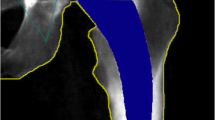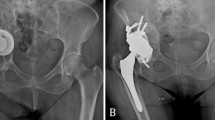Abstract
Introduction
The aim of this prospective study was to evaluate load-transfer mechanisms and stress patterns of periacetabular cortical and cancellous bone after cemented total hip arthroplasty (THA) in vivo using computed tomography (CT) assisted osteodensitometry. In addition we analyzed the efficacy of CT in detecting radiolucent lines around the acetabular component compared to plain radiography.
Materials and methods
Twenty-two cemented acetabular cups were investigated using conventional sequential axial CT scans (Ø 8 days and 26 months post-OP) and plain radiography (Ø 5 days and 40 months post-OP). CT assisted osteodensitometry was used to determine cancellous and cortical bone bone density (BD). Radiolucent lines were evaluated using both CT and plain radiography.
Results
Significant BD loss at the time of follow-up was only detectable ventral to the cup (cortical bone: −16%, P = 0.001; cancellous bone: −31%, P = 0.001). The BD changes dorsal and cranial to the cup were not significant. Postoperatively no radiolucent lines were observed in the cement-bone interface by CT, while on plain radiography acetabular lucent lines were seen in 12 out of 22 cases.
Conclusion
CT-osteodensitometry has the technical ability to discriminate between cortical and cancellous bone structures with respect to strain-adapted remodeling: sufficient cancellous and cortical bone stock remained dorsal and cranial to the cup indicative of a balanced load transfer to these regions. CT-osteodensitometry has the potential to become an effective instrument for quality control in THA and the method of choice for in vivo determination of periprosthetic BD. In contrast, plain radiography is more suitable for the early detection of radiolucent lines compared to axial CT scans.




Similar content being viewed by others
References
Bischoff JE (2004) Static indentation of anisotropic biomaterials using axially asymmetric indenters—a computational study. J Biomech Eng 126(6):855
Brodner W, Bitzan P, Lomoschitz F, Krepler P, Jankovsky R, Lehr S, Kainberger F, Gottsauner-Wolf F (2004) Changes in bone mineral density in the proximal femur after cementless total hip arthroplasty. A five-year longitudinal study. J Bone Joint Surg Br 86(1):20–26
Carter DR, Vasu R, Harris WH (1982) Stress distributions in the acetabular region−2. Effects of cement thickness and metal backing of the total hip acetabular component. J Biomech 15:165–170
Carter DR, Vasu R, Harris WH (1983) Periacetabular stress distributions after joint replacement with subchondral bone retention. Acta Orthop Scand 54:29–35
Charnley J (1961) Arthroplasty of the hip. A new opeartion. Lancet 1:1129–1132
DeLee JG, Charnley J (1976) Radiological Demarcation of Cemented Sockets in Total Hip Replacement. Clin Orthop Relat Res 121:20–32
Draenert KD, Draenert YI, Krauspe R, Bettin D (2005) Strain adaptive bone remodelling in total joint replacement. Clin Orthop Relat Res 430:12–27
Goodman SB, Carter DR (1987) Acetabular lucent lines and mechanical stress in total hip arthroplasty. J Arthroplasty 2(3):219–224
Harris WH (1969) Traumatic arthritis of the hip after dislocation and acetabular fractures: treatment by mold arthroplasty. An end-result study using a new method of result evaluation. J Bone Joint Surg Am 51(4):737–755
Huiskes R (1987) Finite element analysis of acetabular reconstruction. Noncemented threaded cups. Acta Orthop Scand 6:620–625
Huiskes R, Weinans H, Dalstra M (1989) Adaptive bone remodeling and biomechanical design considerations for noncemented total hip arthroplasty. Orthopedics 9:1255–1267
Hultmark P, Hostner J, Herberts P, Karrholm J (2003) Radiographic evaluation of Charnley cups used in first-time revision: repeated observations for 7–15 years. J Arthroplasty 18:1005–1015
Kalender WA (1992). A phantom for standardization and quality control in spinal bone mineral measurements by QCT and DXA: design considerations and specifications. Med Phys 19(3):583–586
Krischak GD, Augat P, Wachter NJ, Kinzl L, Claes LE (1999) Predictive value of bone mineral density and Singh index for the in vitro mechanical properties of cancellous bone in the femoral head. Clin Biomech (Bristol, Avon) 14:346–351
Krischak GD, Wachter NJ, Zabel T, Suger G, Beck A, Kinzl L, Claes LE, Augat P (2003) Influence of preoperative mechanical bone quality and bone mineral density on aseptic loosening of total hip arthroplasty after seven years. Clin Biomech (Bristol, Avon) 18:916–923
Looney RJ, Boyd A, Totterman S, Seo GS, Tamez-Pena J, Campbell D, Novotny L, Olcott C, Martell J, Hayes FA, O’Keefe R, Schwarz M (2002) Volumetric computerized tomography as a measurment of periprosthetic acetabular osteolysis and its correlation with wear. Arthritis Res 4:59–63
Mueller LA, Kress A, Nowak T, Pfander D, Pitto RP, Forst R, Schmidt R (2006) Evaluation of periacetabular bone changes after uncemented total hip arthroplasty using quantitative computed tomography. Acta Orthop 77(3):380–385
Mueller LA, Nowak TE, Völk M, Pitto RP, Pfander D, Forst R, Schmidt R, Eichinger S (2006) Analysis of the periprosthetic femoral bone reaction after uncemented total hip arthroplasty with computertomography assisted osteodensitometry in vivo: 6-year follow-up. Biomed Tech 51:139–144
Pedersen DR, Crowninshield RD, Brand RA, Johnston RC (1982) An axisymmetric model of acetabular components in total hip arthroplasty. Biomechanics 15:305–315
Rapperport DJ, Carter DR, Schurman DJ (1987) Contact finite element stress analysis of porous ingrowth acetabular cup implantation, ingrowth, and loosening. J Orthop Res 5(4):548–561
Ritter MA, Zhou H, Keating CM, Keating EM, Faris PM, Meding JB, Berend ME (1999) Radiological factors influencing femoral and acetabular failure in cemented Charnley total hip arthroplasties. J Bone Joint Surg Br 81:982–986
Sabo D, Reiter A, Simank H G, Thomsen M, Lukoschek M, Ewerbeck V (1998) Periprosthetic mineralization around cementless total hip endoprosthesis: longitudinal study and cross-sectional study on titanium threaded acetabular cup and cementless Spotorno stem with DEXA. Calcif Tissue Int 2:177–182
Schmidt R, Pitto RP, Kress A, Ehremann C, Nowak TE, Reulbach U, Forst R, Muller L (2005) Inter- and intraobserver assessment of periacetabular osteodensitometry after cemented and uncemented total hip arthroplasty using computed tomography. Arch Orthop Trauma Surg 125(5):291–297
Schmidt R, Nowak TE, Mueller L, Pitto RP (2004) Osteodensitometry after total hip replacement with uncemented taper-design stem. Int Orthop 28(2):74–77
Schroeder-Boersch H (1998). Die Radiologischen Ergebnisse der ARO-Multicenterstudie. Der Orthopäde 27:333–340
Venesmaa PK, Kroger HP, Miettinen HJ, Jurvelin JS, Suomalainen OT, Alhava EM (2001) Monitoring of periprosthetic BMD after uncemented total hip arthroplasty with dual-energy X-ray absorptiometry—a 3-year follow-up study. J Bone Miner Res 16(6):1056–1061
Wachter NJ, Krischak GD, Mentzel M, Sarkar MR, Ebinger T, Kinzl L, Claes L, Augat P (2002) Correlation of bone mineral density with strength and microstructural parameters of cortical bone in vitro. Bone 31:90–95
Wilkinson JM, Hamer AJ, Rogers A, Stockely I, Eastell R (2003) Bone mineral density and biochenical markers of bone turnover in aseptic loosening after totalö hip arthroplasty. J Orthop Res 21:691–696
Wright JM, Pellicci PM, Salvati EA, Ghelman B, Roberts MM, Koh JL (2001) Bone density adjacent to press-fit acetabular components. A prospective analysis with quantitative computed tomography. J Bone Joint Surg (Am) 83:529–536
Wolff J (1892) Das Gesetz von der Transformation des Knochens. Hirschwald, Berlin
Author information
Authors and Affiliations
Corresponding author
Additional information
Lutz Arne Mueller and Tobias Eckhard Nowak contributed equally to this paper.
Rights and permissions
About this article
Cite this article
Mueller, L.A., Nowak, T.E., Mueller, L.P. et al. Acetabular cortical and cancellous bone density and radiolucent lines after cemented total hip arthroplasty: a prospective study using computed tomography and plain radiography. Arch Orthop Trauma Surg 127, 909–917 (2007). https://doi.org/10.1007/s00402-007-0304-0
Received:
Published:
Issue Date:
DOI: https://doi.org/10.1007/s00402-007-0304-0




